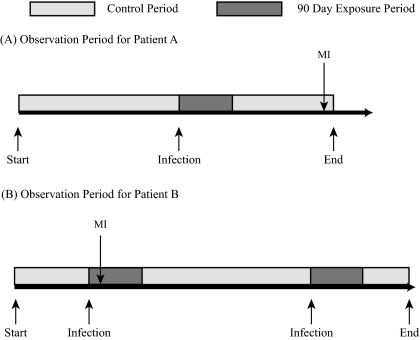Figure 1.
The exposure period is defined as the 90 days after an infection-related hospitalization (dark boxes). The control period for an individual includes all days in the observation period that are not during an exposure interval (gray boxes). For example, patient A had one infection-related hospitalization during follow-up and one myocardial infarction (MI) in the control period. Patient B had two infection-related hospitalizations and therefore two 90-day exposure periods during follow-up. Patient B had one MI in the first exposure period and none in the control period. Relative incidence estimates are derived from comparing rates of cardiovascular events between exposed and control periods, and the length of follow-up may be different for different patients, as illustrated with patients A and B. Each patient serves as their own control (self-controlled) and the method focuses on event rates in the exposure and control periods within each individual's observation period. Combining this information across all study individuals provides an estimate of the relative incidence.

